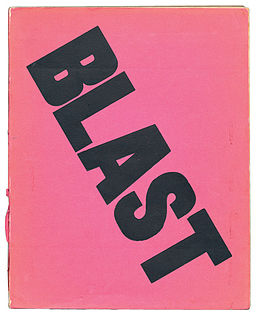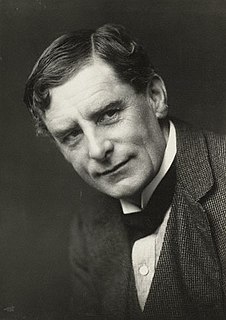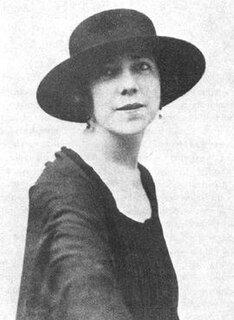Wyndham Lewis may refer to:
- Percy Wyndham Lewis (1882–1957), English artist and writer
- Wyndham Lewis (politician), MP whose widow married Disraeli
- D. B. Wyndham Lewis, humorist and biographer
Wyndham Lewis may refer to:
New Yorker or variant may refer to:

Percy Wyndham Lewis was a British writer, painter and critic. He was a co-founder of the Vorticist movement in art and edited BLAST, the literary magazine of the Vorticists.

Vorticism was a London-based modernist art movement formed in 1914 by the writer and artist Wyndham Lewis. The movement was partially inspired by Cubism and was introduced to the public by means of the publication of the Vorticist manifesto in Blast magazine. Familiar forms of representational art were rejected in favour of a geometric style that tended towards a hard-edged abstraction. Lewis proved unable to harness the talents of his disparate group of avant-garde artists; however, for a brief period Vorticism proved to be an exciting intervention and an artistic riposte to Marinetti's Futurism and the post-impressionism of Roger Fry's Omega Workshops.
Wyndham may refer to:

The Noël Coward Theatre, formerly known as the Albery Theatre, is a West End theatre in St. Martin's Lane in the City of Westminster, London. It opened on 12 March 1903 as the New Theatre and was built by Sir Charles Wyndham behind Wyndham's Theatre which was completed in 1899. The building was designed by the architect W. G. R. Sprague with an exterior in the classical style and an interior in the Rococo style.

Werribee is a suburb of Melbourne, Victoria, Australia, 32 km south-west of Melbourne's Central Business District, located within the City of Wyndham local government area. Werribee recorded a population of 40,345 at the 2016 Census.

Blast was the short-lived literary magazine of the Vorticist movement in Britain. Two editions were published: the first on 2 July 1914 and featured a bright pink cover, referred to by Ezra Pound as the "great MAGENTA cover'd opusculus"; and the second a year later on 15 July 1915. Both editions were written primarily by Wyndham Lewis. The magazine is emblematic of the modern art movement in England, and recognised as a seminal text of pre-war 20th-century modernism. The magazine originally cost 2/6.
Hugh Gordon Porteus (1906–1993) was an influential reviewer of art and literature in the London of the 1930s, and also a poet. He was an admirer of Wyndham Lewis and wrote the first critical book on him, published in 1932. Lewis portrayed Porteus as the character "Rotter" Parkinson in his novel Self Condemned.
Francisation of traditional English "Bullen", or possibly the Westslavic or Scandinavian name Bolling, Boleyn is the surname of a noble English family particularly prominent in the Tudor period, members of which include:

The Apes of God is a 1930 novel by the British artist and writer Wyndham Lewis. It is a satire of London's contemporary literary and artistic scene. The Sitwells, Gertrude Stein, James Joyce, and Virginia Woolf and the Bloomsbury group are among the writers satirised.
Dominic Bevan Wyndham Lewis FRSL was a British journalist, author and biographer, known for his humorous newspaper articles

Group X was a short-lived British artistic movement in the years after the First World War. Several of its members – among them Wyndham Lewis – had been part of the Vorticist movement before the War. The group held a single exhibition in 1920; others were planned, but never happened.

The Camden Town Group was a group of English Post-Impressionist artists founded in 1911 and active until 1913. They gathered frequently at the studio of painter Walter Sickert in the Camden Town area of London.

Wyndham's Theatre is a West End theatre, one of two opened by actor/manager Charles Wyndham. Located on Charing Cross Road in the City of Westminster, it was designed c.1898 by W. G. R. Sprague, the architect of six other London theatres between then and 1916. It was designed to seat 759 patrons on three levels; later refurbishment increased this to four seating levels. The theatre was Grade II* listed by English Heritage in September 1960.

Wyndham is the northernmost town in the Kimberley region of Western Australia, located on the Great Northern Highway, 2,210 kilometres (1,373 mi) northeast of Perth. It was established in 1886 to service a new goldfield at Halls Creek, and it is now a port and service centre for the east Kimberley with a population of 780. Aboriginal and Torres Strait Islander people make up 54% of the population. Wyndham comprises two areas - the original town site at Wyndham Port situated on Cambridge Gulf, and 5 kilometres (3.1 mi) by road to the south, the Three Mile area with the residential and shopping area for the port, also founded in 1886. Wyndham is part of the Shire of Wyndham-East Kimberley.

Sir Wyndham Knatchbull-Wyndham, 6th Baronet was a British baronet and Whig politician.
Charles Wyndham or Windham may refer to:
Percy Wyndham may refer to:

Kate Elizabeth Lechmere was a British painter who with Wyndham Lewis was the co-founder of the Rebel Art Centre in 1914. As far as is known, none of Lechmere's paintings have survived. She served as a nurse in England during the First World War and had a three-year relationship with the poet and critic T.E. Hulme before he was killed. After the war she became a successful milliner.

The Wild Body is a series of short stories by Wyndham Lewis that appeared in English and American publications between 1917 and 1922. Nine short stories comprise a series that follows the narrator Ker-Orr in his adventures around Brittany. The first of the series, A Soldier of Good Humour, first appeared in the December 1917 and January 1918 editions of American Literary publication The Little Review. Other stories in the collection are: Beau Sejour, The Cornac and His Wife, The Death of the Ankou, Franciscan Adventures, Brotcotnaz, Inferior Religions and The Meaning of the Wild Body. A later story, Sigismund, was written in 1922 and appeared in Arts and Letters. The final story is You Broke My Dream also written in 1922. The collected short stories were published in a single edition by Chatto & Windus of London in 1927, and Harcourt Brace of New York in 1928.